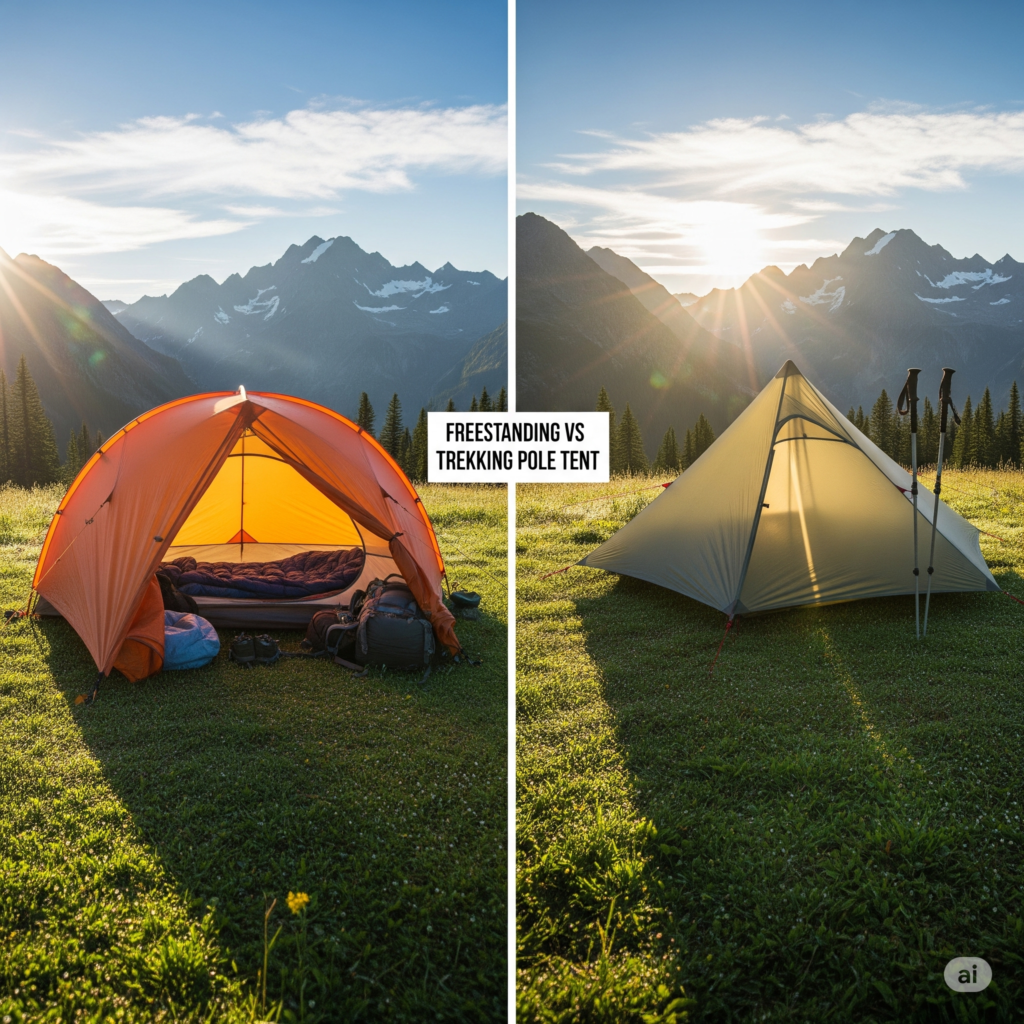When it comes to choosing a tent, most campers end up comparing two main types: the freestanding tent and the trekking pole tent. Both can give you shelter in the backcountry, but they are built differently, work differently, and suit different needs. If you are planning a trip and trying to decide between them, it’s worth taking the time to understand how each one functions in real situations.
This guide breaks down the key points so you can make an informed choice without getting lost in marketing talk.
What Makes a Tent “Freestanding”?
A freestanding tent is designed to hold its shape without needing to be staked down first. It has its own dedicated poles — usually aluminum or lightweight composite — that slot together to create a frame. Once those poles are in place, the tent stands on its own. You can move it around the campsite before you stake it, which is handy if you realize you picked a spot with a rock or root underneath.
These tents are popular because they are easy to set up and forgiving in tricky conditions. If the ground is too hard to drive stakes, you can still use a freestanding tent and secure it with rocks or gear for extra stability.
What Is a Trekking Pole Tent?
A trekking pole tent skips the traditional pole system entirely. Instead, it uses the trekking poles you already carry on the trail as the main support. This design makes the tent lighter because you aren’t carrying a second set of poles. The fabric is often shaped like an A-frame or pyramid, and the tension comes from staking the tent to the ground.
This means setup requires good staking points. If you’re camping on rocky terrain where stakes won’t hold, you’ll have to improvise with rocks or tie-outs.
Why the Comparison Matters
Choosing between a freestanding and a trekking pole tent isn’t just about weight. It affects how you set up camp, where you can pitch the tent, how it handles bad weather, and how comfortable you’ll be after a long day on the trail. For hikers counting every gram, trekking pole tents can be a game-changer. For those who value quick setup in unpredictable terrain, a freestanding tent might make more sense.
The “freestanding vs trekking pole tent” debate is really a question of priorities. You have to decide which features you’re willing to trade for others.
Weight and Packability
One of the biggest differences between these tents is weight. Freestanding tents come with a dedicated pole set. Even ultralight versions still add a few hundred grams because of the frame. Trekking pole tents don’t need extra poles, so they’re usually lighter. Some models weigh under a kilogram.
Weight affects packability too. Trekking pole tents tend to pack down smaller, leaving more space in your pack for food, clothing, or other gear. However, the lightest options sometimes use thinner fabrics that require more care.
If you’re planning long-distance hikes, you might feel that every saved gram is worth it. On shorter trips where comfort matters more than pack weight, the difference might not be as important.
Setup Time and Ease
A freestanding tent can be pitched in a few minutes. You snap the poles together, clip or slide the fabric on, and you’re ready. Even if the ground is rocky or sandy, the tent stands without much fuss. This can be a huge relief if you arrive at camp tired, wet, or racing daylight.
A trekking pole tent takes more thought. You need to position the stakes correctly to get the right tension, adjust pole height, and sometimes move things around until it’s even. In soft ground, the stakes hold well, but in loose soil or hard rock, setup can take longer.
If you camp in places with unpredictable ground conditions, that’s worth factoring in.
Weather Performance
Weather handling depends on design and build quality more than the category of tent, but there are some general trends.
Freestanding tents often have stronger wind resistance because of their rigid frame. They hold shape better when gusts hit. Many also come with full-coverage rainflies, which keep water out even in driving rain.
Trekking pole tents can be very weather-resistant if pitched correctly, but they rely on constant fabric tension. If stakes pull loose or the ground shifts, the tent can sag or collapse. That said, a well-pitched trekking pole tent with low sides can handle storms surprisingly well — but it requires experience.
Interior Space and Comfort
Freestanding tents usually feel more spacious because the walls are more vertical. You can sit up inside, move around, and use the full footprint. This makes them more comfortable for longer stays or when you’re sharing the tent.
Trekking pole tents often have sloped walls, which reduce usable interior space. You might need to be mindful of where your head and feet go to avoid brushing the fabric. For solo hikers, this is less of a problem. For two people, it can feel cramped.
If you spend a lot of downtime in your tent — reading, cooking under shelter, or waiting out storms — interior space becomes more important.
Durability
Durability comes down to materials and care. Freestanding tents use stronger poles that help maintain shape even if the fabric loosens slightly over time. They also tend to have more robust floors.
Trekking pole tents often use lighter materials to keep weight down. These can be plenty durable with proper care, but they won’t tolerate rough treatment as well. Sharp rocks, high UV exposure, or repeated stress on the fabric can shorten their life.
If you treat your gear gently, a trekking pole tent can last many seasons. If you’re rough on equipment, the extra durability of a freestanding model might be worth the weight.
Cost Differences
Prices vary widely in both categories. High-end trekking pole tents made from Dyneema or other ultralight fabrics can cost as much — or more — than premium freestanding tents. At the budget end, freestanding tents are often cheaper because they use simpler materials.
However, if you already own trekking poles, a trekking pole tent means you’re buying fewer components. For someone starting from scratch, the price difference may not be huge.
Versatility in Campsite Choice
One overlooked difference between freestanding vs trekking pole tent setups is where you can camp. A freestanding tent lets you pitch on hard rock, wooden platforms, sand, or snow without much trouble. You just weigh it down with gear or rocks if stakes won’t hold.
Trekking pole tents need good stake points for proper structure. On wooden platforms or slick rock, pitching can be a challenge without extra gear like guylines, anchors, or cords.
If you camp in varied terrain or places where staking is difficult, a freestanding tent has a clear edge.
Ventilation
Condensation can make any tent uncomfortable. Freestanding tents often have mesh panels and multiple vents that keep airflow steady. Even in rain, you can adjust vents to limit moisture build-up.
Trekking pole tents can be ventilated well too, but their shape sometimes makes airflow trickier in calm weather. Good site choice — like finding a spot with a slight breeze — helps keep the interior dry.
Learning Curve
For beginners, freestanding tents are easier to master. You can figure them out in your backyard in minutes. There’s little chance of pitching them wrong.
Trekking pole tents have more of a learning curve. Getting the right pitch angle, pole height, and stake placement takes practice. Experienced hikers often love them, but a first-time user might find them frustrating on the trail.
Environmental Impact
Carrying less weight means you use less energy and can travel farther without as much strain. In that sense, trekking pole tents have a small environmental advantage. They also cut down on the amount of manufactured material you carry, since the poles are multi-use.
However, freestanding tents often last longer because of their stronger materials. If longevity means fewer replacements, that can balance out the footprint.
Who Should Choose a Freestanding Tent?
Pick a freestanding tent if you value:
- Quick, easy setup
- Stability in rough weather
- Comfort and space
- Flexibility in campsite choice
- Durability over minimal weight
These are the go-to choice for many casual campers, paddlers, and those exploring regions with unpredictable ground conditions.
Who Should Choose a Trekking Pole Tent?
A trekking pole tent makes sense if you:
- Prioritize low weight above all
- Already carry trekking poles daily
- Have experience pitching in varied conditions
- Can manage with less interior space
- Camp mostly on soil or grass where stakes hold well
They’re a favorite among long-distance hikers who measure every gram and don’t mind a little extra setup work.
Final Thoughts
The freestanding vs trekking pole tent choice isn’t about which is objectively “better.” It’s about what works best for your style of camping. A weekend backpacker on mixed terrain might lean toward a freestanding tent for ease and comfort. A thru-hiker crossing hundreds of miles might pick a trekking pole tent for the weight savings.
Before buying, try borrowing or renting both types. Setting them up in real conditions will tell you more than any spec sheet.
Whatever you choose, remember that the best tent is the one you’ll actually take into the wild — not the one sitting in a closet because it feels like a compromise.


